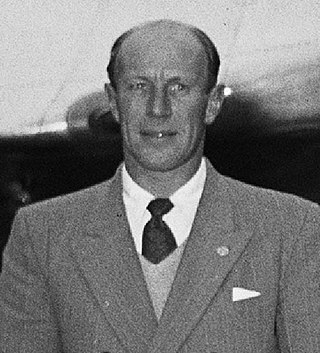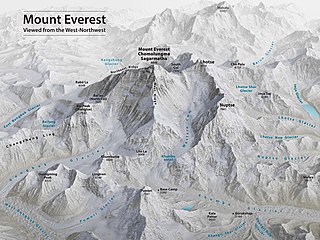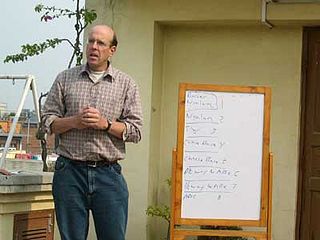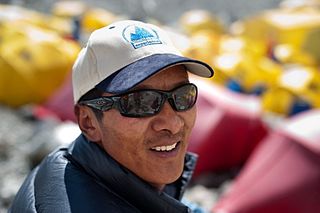
Mount Everest is Earth's highest mountain above sea level, located in the Mahalangur Himal sub-range of the Himalayas. The China–Nepal border runs across its summit point. Its elevation of 8,848.86 m was most recently established in 2020 by the Chinese and Nepali authorities.

Raymond Lambert was a Swiss mountaineer who together with Sherpa Tenzing Norgay reached an altitude of 8611 metres of Mount Everest, as part of a Swiss Expedition in May 1952. At the time it was the highest point that a climber had ever reached. There was a second Swiss expedition in autumn 1952, but a party including Lambert and Tenzing was forced to turn back at a slightly lower point. The following year Tenzing returned with Edmund Hillary to reach the summit on 29 May 1953.

Robert Edwin Hall was a New Zealand mountaineer. He was the head guide of a 1996 Mount Everest expedition during which he, a fellow guide, and two clients died. A best-selling account of the expedition was given in Jon Krakauer's Into Thin Air, and the expedition has been dramatised in the 2015 film Everest. At the time of his death, Hall had just completed his fifth ascent to the summit of Everest, more at that time than any other non-Sherpa mountaineer.

Mark Joseph Inglis is a New Zealand mountaineer, researcher, winemaker and motivational speaker. He holds a degree in Human Biochemistry from Lincoln University, New Zealand, and has conducted research on leukaemia. He is also an accomplished cyclist and, as a double leg amputee, won a silver medal in the 1 km time trial event at the 2000 Summer Paralympics in Sydney. He is the first double amputee to reach the summit of Mount Everest, the highest mountain in the world above sea level.

Mount Everest is the world's highest mountain, with a peak at 8,849 metres (29,031.7 ft) above sea level. It is situated in the Himalayan range of Solukhumbu district, Nepal.
Lincoln Ross Hall OAM was a veteran Australian mountain climber, adventurer and author. Lincoln was part of the first Australian expedition to climb Mount Everest in 1984, which successfully forged a new route. He reached the summit of the mountain on his second attempt in 2006, miraculously surviving the night at 8,700 m (28,543 ft) on descent, after his family was told he had died.

David Sharp was an English mountaineer who died near the summit of Mount Everest. His death caused controversy and debate because he was passed by a number of other climbers heading to and returning from the summit as he was dying, although a number of others tried to help him.

Daniel Lee Mazur is a mountain climber, expedition leader, and philanthropist who has ascended nine of the world's highest summits, including Mount Everest and K2. In addition, he is known for several high altitude mountain rescues: the 1991 rescue of Roman Giutashvili from Mount Everest, the rescue of Gary Ball from K2 in 1992, the rescue in 2006 of Australian climber Lincoln Hall from Mount Everest, and the rescue of British mountaineer Rick Allen from Broad Peak in 2018.
Russell Reginald Brice is a New Zealand mountaineer. He was the owner/manager of Himex, a climbing expedition company. He has summited Cho Oyu seven times, Himal Chuli and Mount Everest twice, as well as Manaslu in October 2010, which was his 14th summit of an 8000 m peak.

The 1996 Mount Everest disaster occurred on 10–11 May 1996 when eight climbers caught in a blizzard died on Mount Everest while attempting to descend from the summit. Over the entire season, 12 people died trying to reach the summit, making it the deadliest season on Mount Everest at the time and the third deadliest after the 22 fatalities resulting from avalanches caused by the April 2015 Nepal earthquake and the 16 fatalities of the 2014 Mount Everest avalanche. The 1996 disaster received widespread publicity and raised questions about the commercialization of Everest.

Phurba Tashi Sherpa Mendewa is a Nepalese Sherpa mountaineer known for his numerous ascents of major Himalayan peaks. These include 21 ascents of Mount Everest, five on Cho Oyu, two on Manaslu, and one each on Shishapangma and Lhotse.

Adrian Ballinger is a British-American certified IFMGA/AMGA mountain guide, certified through the American Mountain Guides Association and a sponsored climber and skier. Ballinger is the founder and CEO of Alpenglow Expeditions, and has been guiding full-time for 25 years. He has led over 150 international climbing expeditions on six continents, and made 18 successful summits of 8,000m peaks. He is known for pioneering the use of pre-acclimatization for commercial expeditions as early as 2012, which can cut the amount of time typically spent on an expedition in half. Adrian is the only American to have made three successful ski descents of 8,000m peaks, including the first ski descent of Manaslu from its summit. He is also the fourth American to have summited both Mount Everest and K2 without the use of supplemental oxygen.

The 1953 British Mount Everest expedition was the ninth mountaineering expedition to attempt the first ascent of Mount Everest, and the first confirmed to have succeeded when Tenzing Norgay and Edmund Hillary reached the summit on 29 May 1953. Led by Colonel John Hunt, it was organised and financed by the Joint Himalayan Committee. News of the expedition's success reached London in time to be released on the morning of Queen Elizabeth II's coronation, on 2 June that year.

The 1975 British Mount Everest Southwest Face expedition was the first to successfully climb Mount Everest by ascending one of its faces. In the post-monsoon season Chris Bonington led the expedition that used rock climbing techniques to put fixed ropes up the face from the Western Cwm to just below the South Summit. A key aspect of the success of the climb was the scaling of the cliffs of the Rock Band at about 8,200 metres (27,000 ft) by Nick Estcourt and Tut Braithwaite.

Himex is a Mount Everest guiding company. It was founded in 1996 by New Zealander Russell Brice. The name is a truncated version of the full name "Himalayan Experience". National Geographic said Himex was the "largest and most sophisticated guiding operation on Everest" in a 2013 article. Himex's team is known for fixing lines on Mount Everest, although in 2012 other teams did this work.

The Mount Everest climbing season of 2017 began in spring with the first climbers reaching the top on May 11, from the north side. The first team on the south side reached the top on May 15. By early June, reports from Nepal indicated that 445 people had made it to the summit from the Nepali side. Reports indicate 160–200 summits on the north side, with 600–660 summiters overall for early 2017. This year had a roughly 50% success rate on that side for visiting climbers, which was down from other years. By 2018, the figure for the number of summiters of Everest was refined to 648. This includes 449 which summited via Nepal and 120 from Chinese Tibet.

Mount Everest in 2016 covers events about Mount Everest, the highest mountain on Earth located in Nepal and Chinese Tibet in Asia. It is a popular climbing destination for extreme high altitude climbers, with several hundred climbing each year despite various dangers.

Mount Everest in 2018 is about events in the year about the highest Earth mountain, Mount Everest, a popular mountaineering tourism and science destination in the 2010s. In 2018, 807 climbers summited Mount Everest, which is a popular mountaineering goal. This year is noted for an especially long weather window of 11 days straight of calm, which reduced crowding at the high base camps. With over 800 reaching the top, it was the highest amount ever to reach the top in recorded history, besting the previous year by over 150 summitings.

















